Motor Yachts in High Following Seas
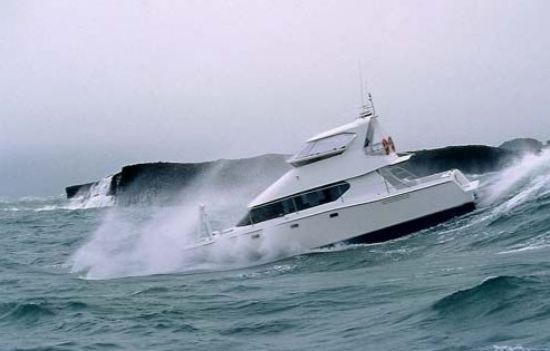
Running before a big following sea has the reputation of being the seaman’s nightmare, conjuring up visions of broaching, capsizing or being swamped. Much of this fear stems from sailing boats, where running before a sea may be the only action left under extreme conditions. There is no doubt that following seas have their dangers, but if you understand what these dangers might be, and you have a boat with good control they can be compensated for and the dangers minimized.
At first glance, it would appear that running before a sea and traveling in the same direction as the wind and sea would be a far safer course to take than battling against the waves. However, many boats are controlled by rudders. A rudder needs a good flow of water running past it from forward to aft to be effective. If the water flow is reduced or even reversed because of an overtaking breaking wave, then there will be much less control of the boat. It is this factor that presents the major hazard in a following sea.
Advantage -- Pods. If your boat has dynamic steering, as with outboards and sterndrives where you use the propeller thrust for steering, then you will have much better control. This is one of the advantages to pod drives that is rarely mentioned, but worth considering.
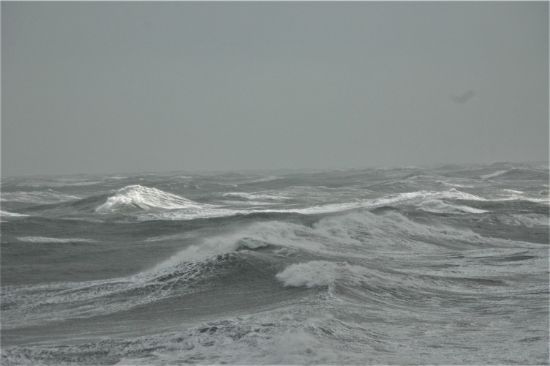
Wave Speed
Average open sea waves will be traveling at somewhere between two and three times the speed of the average displacement boat, so the wave will take some time to pass the boat. When the crest of the wave is approaching the stern, this face of the wave is the steepest part, and the bow will be pointing downwards towards the trough as the stern lifts. In this position, gravity will exert a downward pull on the boat, combining with the thrust from the propeller leading to the boat, and gaining increased forward motion down the wave slope.
Similarly, when the boat is on the back of the wave with the bow pointing upwards, it is going uphill and the speed will be correspondingly reduced. These involuntary increases and decreases in speed can be controlled to a degree by opening and closing the throttle as the circumstances dictate. Unless the waves are breaking, it should be possible to retain adequate control over the boat – but, beware of closing the throttle completely as you will lose steering control.
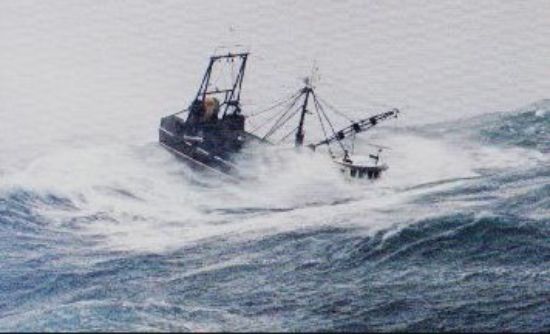
When the wave crests are breaking, the surface water is moving forward in the direction of travel of the wave at a speed slightly over the speed of the wave. This forward movement of the breaking crest is transient, starting as the wave crest becomes unstable and ending when the wave has reached stability again and stopped breaking.
Unlike non-breaking waves, when the crest is breaking the water is moving forward. This is why you might lose steering because the water is flowing past the rudder from aft to forward.
Effect on Hulls
The water in that breaking crest that is flowing forward is probably no more than 3' (0.9 m) deep with solid water below. This means that a shallow draft boat will be affected considerably by such a breaking crest. But a deeper draft boat with its rudder well immersed should still retain regular steerage control in this breaking wave situation, whereas the shallow draft boat could be much more vulnerable.
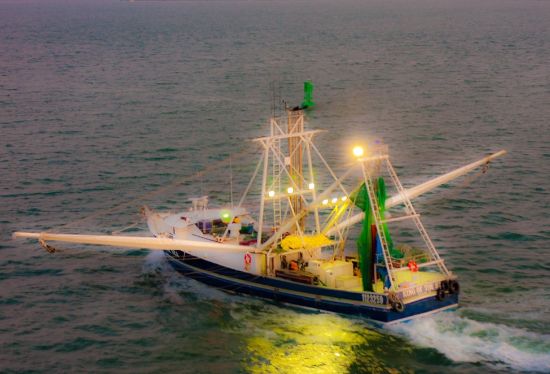
So, when running before a following sea in a displacement boat when the wave crests are breaking, the boat can accelerate under the combined influences of the rush of breaking water at the stern and the downward slope of the wave. This would not pose much danger if the boat could just keep accelerating in this way. However, as the stern is lifted by the rush of water the time comes when the bow of the boat starts to bury into the next wave ahead.
The Cause of Broaching
When the bow begins to bury, it starts to act as a pivot or fulcrum at the same time that the immersed bow adds considerable resistance to the forward rush. It is at this point that the risk of broaching occurs, with the bow wanting to slow down and the reduction in the steering control allowing the stern to swing to one side or the other. This strong turning effect can turn the boat broadside on in the classic broaching situation.
Once broadside on the sea, the turning moment reduces but is then replaced by a capsizing moment similar to that which can be found in a beam sea. Even if the boat escapes this particular situation, it could well find itself vulnerable to the next wave that comes along, because it is unlikely that it will have recovered in time and achieved the steerage way necessary to cope with the situation.
Found in this situation with a breaking wave approaching at the stern, there is not a great deal that can be done, other than trying to keep the boat square on to the sea for as long as possible and opening the throttle wide.
Steering Control
This will demand concentration and hard work with the steering wheel, although the rudder may become less effective in these conditions. As a general rule, the throttle should be opened as wide as possible to try to run from the breaking wave or at least reduce its impact, and to help retain steerage control for as long as possible. This will also have the effect of lifting the bow to a certain extent and it will also help to reduce the impact of the wave at the stern.
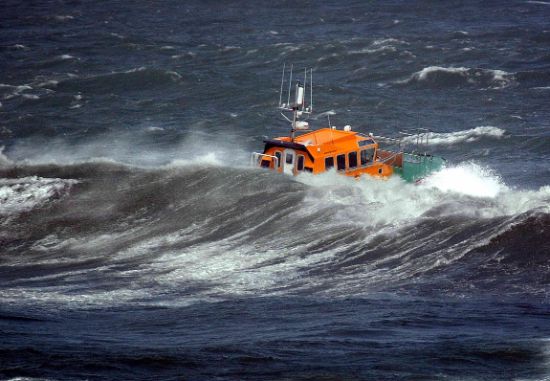
When running before a big following sea, full throttle should be used to maintain steering control. Try to keep pace with the waves as far as possible although on a displacement boat the waves will be overtaking. In these conditions, it may be noticed that the waves astern are starting to break, but this is again usually the influence of the wash of the boat combining with the approaching crest, which causes it to break. This can be a significant problem when crossing a harbor bar in a following sea, and quite harmless looking waves can suddenly rear up astern in this situation.
It seems that the extra disturbance caused by the progress of the boat is enough to turn the waves into an unstable form, although in theory, these breaking waves that are assisted by the wash from the boat should not cause any problems, even though they present a frightening picture when looking astern. In an earlier article, we have looked at the possible reduction in stability that can occur in a following sea when the boat is on the crest of the wave so the speed should be adjusted to reduce the time on the crest to a minimum.
One problem found on many boats when operating in a following sea is that the visibility astern is not as good as it might be. It helps a great deal to have a good view astern, and on each quarter as well, but many boats lack this facility.
Exciting Ride
With a well-found boat, running before a heavy following sea can be a very exciting experience. The first hour or two in a following sea can be quite frightening until the crew becomes used to the conditions. Once confidence is gained that the boat is adequate for the job, revel in the excitement of rushing like an express train down the face of a wave.
Perhaps an unnecessary dread of following seas has been built up among the small boat fraternity, but one needs a sound boat before taking chances in a following sea, or indeed in any rough sea -- and concentration is vital.
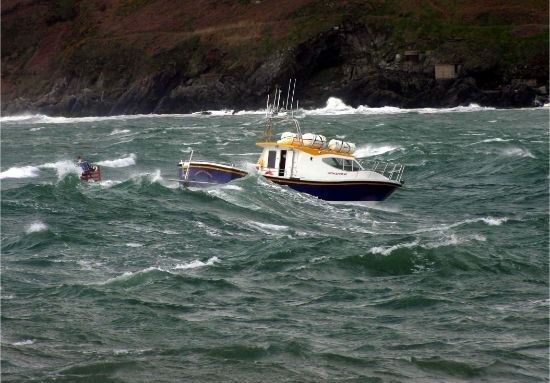
In conditions where the sea is starting to become rough when running before it, quite dangerous conditions can build up because you are less aware of just how bad things are getting. To a certain extent, you are running in harmony with the sea and the lack of impact with the waves can lull you into a false sense of security. Thus, it is a sensible precaution to stop every now and again, turn around, and head into the sea, just to see what conditions are really like. It might be frightening to realize just how the waves are building up, but it is better to be frightened in this way than to be caught off guard.
Planing Boats
If you are in a planing powerboat, you have more flexibility and control than with a displacement boat. Now, you can dictate where you are in relation to the waves. You are likely to have dynamic steering and the throttle as an effective control. The speed of encounter with the waves is much slower than with a head sea, so you have more time to adjust the throttle control. The speed at which the waves travel is determined by their height and wavelength, so that smaller waves will be traveling at 12-15 knots and the larger waves, perhaps those generated by a force 5-6 wind, maybe traveling at between 15 and 20 knots.
Certainly, in coastal waters you are unlikely to find waves traveling at more than 20 knots. With a moderate speed planing boat, you should have the potential to overtake following sea waves, possibly even traveling at twice the speed of the waves, so that the period of encounter allows the boat to recover from each wave in turn without any dramatic change of attitude of trim.
With boats capable of speeds up to around 30 knots, it is often possible to simply set the throttle and let the boat take its course while still making rapid speed downwind. Much will depend on the size of the waves and their speed of travel. One of the problems is that, as the craft climbs up the back of the wave it tends to lose speed because it is, in effect, climbing uphill, and then when it gets to the crest it tends to sit there for a moment until enough of the bow projects over the steeper leeward face of the wave to cause it to drop with a quite sudden change of trim.
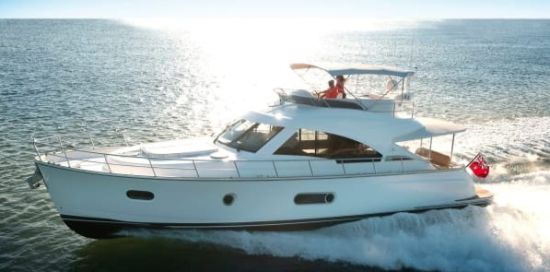
This all tends to happen in slow motion. Relatively speaking, with the boat on the crest of the wave traveling a little faster than the wave itself, there is a marked change in attitude as the boat drops down the leeward face of the wave, and at the same time suddenly accelerates. This acceleration is under the impetus of the throttle and gravity. In rough conditions and depending on a great deal on the speed and type of the boat and the speed of the waves, you can find the bow of the vessel burying quite heavily into the next wave in front as it rushes down the downhill slope. Certainly, with a boat with a full bow, you could find the impact of the boat into the wave quite harsh, giving a very uncomfortable motion.
There are two remedies in this situation if it becomes uncomfortable, which is likely if the wind and waves start to increase. First, if you have the potential to increase speed, it will have the effect of reducing the time that the boat spends on the crest of the wave, thus reducing the dramatic change of trim at the crest. Second, if you do not have the potential to increase the speed you can reduce speed so that the boat will tend to ride with the bow on the upward slope of the wave, virtually keeping pace with the wave. If the wave should disappear in front or break, then you can open the throttle and accelerate over it.
This will give you a slower and more comfortable ride and is the tactic to adopt if you find the sea conditions starting to rise to the point where you feel one ought to nurse the boat. Sitting on the back of the wave in this fashion also requires a fair degree of concentration and a bigger wave may come up behind you which could well be traveling faster than the boat and one could have a potential broaching situation on one’s hands unless you recognize the problem and accelerate away.
Concentration is Important
In rough conditions, say force 7 or upwards, running in a following sea in a planing boat can be one of the safest means of progress, provided of course that you have a sound and reliable boat underneath you. You can still make rapid progress in this direction, at least traveling roughly at the speed of the waves, simply by sitting on the back of a wave and waiting for that wave to collapse or break before driving onwards.
It is not a wise tactic to adopt if you have a long way to travel because one will soon get tired and lose concentration. As always, with a planing boat concentration is the name of the game because in the rough sea the safety margins get smaller and mistakes can soon get you into trouble. The same technique can be used when you are running an inlet, but we will look at this in detail in a later article.
As so often with a planing boat, the best solution when you are not sure about what to do the temptation is to open the throttles and put on more power rather than reduce it and this is particularly the case in following seas. Closing the throttle can cause the bow to drop just when you want it to lift to the next wave. If you are running at slower speeds, you will generally want to keep the flaps up to give the bow as much lift as possible so that the bow doesn’t drop down into the rough as you overtake the waves. At these slower speeds, you also want to bring the power trim in, it is fitted, for the same reason. Both of these controls have less effect at slower speeds anyway.
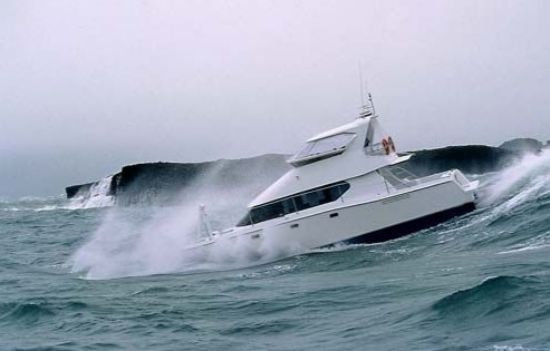
In planing and semi-displacement boats you cannot relax in rough seas in the way that one might with a displacement boat. Semi-displacement hulls such as the Down-easter type tend to have fine bows with a reduced lift so you will want to keep the speed up in those boats and the same applies to some planing hulls particularly the high-performance versions. In following seas, you need to negotiate with the waves rather than use brute force and the need for concentration is paramount.
And, then, the Night Running
If you find yourself running in following seas in the dark, then you have the added problem of not being able to see the waves clearly and you have to start using your instinct or feeling for what the boat is doing. Perhaps this is the time to set the boat on the most comfortable and least demanding course you can find irrespective of destination. Again, a lot will depend on the conditions, but somewhere with the sea, about 30 to 45 degrees on the bow is likely to give the best ride where you can run at reduced speed and still have a reserve to cope with those larger than average waves when they come along.